
NewsNow has obtained information that a speed limit of 80 kilometers per hour has been established for motorists using the Third Mainland Bridge. This decision follows extensive repairs and rehabilitation carried out on both ends of the bridge.
Prior to the reopening of the bridge on April 4, the Lagos State Traffic Management Authority (LASTMA) had cautioned drivers to adhere to the specified speed limit on the Third Mainland Bridge. Motorists were reminded to maintain safe speeds while traversing the newly renovated bridge that connects the Mainland to other parts of the state.
In a statement, the General Manager of LASTMA, Mr. Olalekan Bakare-Oki, issued a strong warning to officers overseeing the operational areas of the Third Mainland Bridge. He emphasized the government’s efforts in installing advanced facilities to aid motorists in efficiently navigating the bridge for timely travel.
Motorists were urged to respect traffic signs and take note of the electronic devices and CCTV cameras in place for enforcement. It was emphasized that time management and vehicle maintenance are crucial for safe travel along the bridge and its connecting roads.
According to an official from the Lagos State Ministry of Transport, who spoke on condition of anonymity, both the Federal and state governments have established the speed limit on the bridge at 80km/h. The official highlighted the presence of CCTV cameras and solar-powered lights on the bridge to ensure compliance with regulations.
The Federal Ministry of Works reassured the public that the CCTV cameras and lights on the Third Mainland Bridge serve not only to promote responsible driving but also to monitor illegal activities. These technological enhancements aim to enhance commuter experience and deter unauthorized activities, such as sand drilling in coastal waters.
During the bridge’s reopening at the Oworonshoki end, the federal controller of Works, Lagos, Olukorede Kesha, emphasized the importance of alleviating motorists’ burdens, especially considering the challenges faced during the repair phase.
